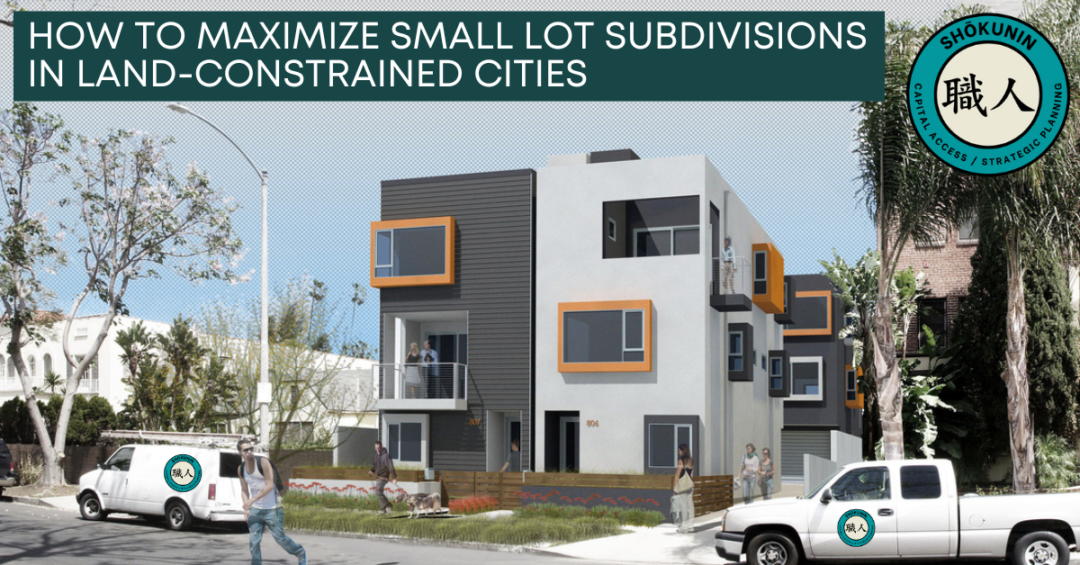In cities like Los Angeles where land is scarce and housing demand is ever-growing, developers need innovative solutions that balance density with livability. The Small Lot Subdivision Ordinance in Los Angeles is a prime example of such a solution.
It allows developers to create fee-simple homeownership opportunities on smaller parcels, combining the benefits of single-family housing with the convenience of multifamily zoning.
This article will explore the key elements, opportunities, challenges, and best practices for maximizing small lot developments in a land-constrained urban environment.
Understanding Small Lot Subdivision: A Hybrid Approach
The Small Lot Subdivision Ordinance was first adopted by the City of Los Angeles in 2005 to address the growing need for increased housing density while maintaining a sense of individual ownership. Unlike typical apartment or condominium projects, small lot developments offer fee-simple ownership, making them an attractive alternative for buyers seeking the benefits of single-family living in an urban setting.
- Key Features of Small Lot Subdivisions:
- Hybrid Housing Typology: Resembles row houses or townhomes, allowing each unit to be built on an individual lot.
- Zoning Flexibility: Applicable in multi-family or commercial zones, making it ideal for infill development.
- Lower Development Barriers: Offers reduced minimum lot size requirements, setbacks, and other regulatory leniencies compared to traditional subdivisions.
Why Small Lot Developments Make Sense in Land-Constrained Cities
Urban land availability is increasingly limited, driving up property values and making traditional single-family developments economically unfeasible in many metropolitan areas. Small lot developments offer a solution to this problem through efficient land use. They allow developers to build multiple detached or semi-detached units on a single parcel while adhering to important urban design considerations. This maximizes the number of housing units per acre without resorting to large, high-rise developments that can face community resistance.
- Advantages for Developers and Buyers:
- Higher Profit Margins: Developers can build and sell more units per parcel, improving profitability.
- Affordable Ownership Opportunities: By offering fee-simple ownership on smaller parcels, these projects can be more affordable than traditional single-family homes, broadening the potential market.
- Flexibility and Customization: The hybrid nature allows developers to customize projects to fit market demands and neighborhood contexts, whether for young professionals, families, or mixed-use living.
Regulatory Framework and Design Standards
The 2018 Small Lot Subdivision Design Standards updates introduced critical guidelines for developers aiming to ensure both compatibility and quality. Understanding these rules is essential for successfully navigating the entitlement process and creating marketable, desirable properties.
- Design Standards Overview:
- Setback Requirements: Increased front and rear yard setbacks ensure compatibility with adjacent structures, especially near single-family neighborhoods.
- Façade Articulation and Roofline Modulation: The design standards encourage variations in building materials, façade treatments, and rooflines to create visual interest and reduce massing.
- Pedestrian Pathways and Landscaping: Common open spaces, well-defined pedestrian pathways, and landscaping requirements enhance community interaction and livability.
2. Administrative Clearance and Review Process:
-
- All small lot projects must undergo an administrative clearance to verify compliance with the updated design standards.
- Developers should consider early engagement with city planners to streamline approvals and avoid common pitfalls.
Key Challenges for Developers
Small lot developments are not without their challenges. The following are some hurdles developers should anticipate and strategically navigate.
- Neighborhood Compatibility: Small lot projects are often proposed in areas with a mix of single-family and multifamily homes. To gain community support and navigate zoning approvals, developers should consider how their projects can integrate into the existing neighborhood fabric.
- Strategy: Incorporate greater setbacks, match rooflines to adjacent homes, and include landscaping that blends with surrounding properties.
2. Space Constraints and Design Limitations: Working with small parcels means every square foot counts. Developers must be innovative in designing units that maximize livable space while meeting regulatory requirements.
-
- Solution: Use smart design solutions like compact floor plans, mezzanine levels, and shared amenities to maximize usable space while keeping costs in check.
3. Parking and Access: Providing adequate parking and efficient access for residents is often challenging due to the smaller footprint of these developments.
-
- Solution: Utilize shared driveways, consider mechanical parking solutions, or negotiate with city officials for reduced parking requirements in exchange for proximity to public transit.
Best Practices for Successful Small Lot Developments
To effectively maximize the potential of small lot developments, developers should consider the following strategies:
- Efficient Land Use Planning: Design with density in mind. Create clusters of homes with shared walls or community spaces to improve land efficiency and maintain a sense of neighborhood.
-
- Example: Group homes into clusters of up to six units with clear pathways and shared open spaces to maintain a communal feel.
2. Flexibility in Design and Layout: Differentiate the units to appeal to a broader audience. Use varied façade materials, staggered entryways, and unique rooflines to create visual interest.
-
- Illustration: The 2018 Design Standards require at least two variations in building design for developments of more than six units, ensuring visual diversity.
3. Community Engagement: Engage with the local community early in the process. Address concerns related to density, parking, and neighborhood compatibility by incorporating feedback into the design phase.
-
- Tactic: Host community workshops or informational sessions to discuss how your development can address local housing needs while respecting the character of the area.
4. Sustainability and Market Appeal: Consider sustainability measures to enhance marketability. Buyers today are increasingly interested in energy-efficient and environmentally friendly homes.
-
- Features to Include: Solar panels, energy-efficient windows, and eco-friendly building materials can add value to the development and make it more appealing to potential buyers.
5. Amenities and Quality of Life: While maximizing density is crucial, the value proposition for buyers is improved when there are community amenities and features that enhance livability.
-
- Design Elements: Include common open spaces, rooftop decks, small courtyards, or shared gardens to provide residents with areas to socialize and relax. Even small additions like bike racks and BBQ areas can make a significant difference.
Market Considerations for Small Lot Developments
Understanding the target market is key to the success of a small lot subdivision project. Market demand, demographic trends, and community needs should all guide the development.
- Target Audience:
- Young Professionals: Often looking for modern, affordable alternatives to traditional single-family homes that are close to urban amenities.
- Downsizers: Older adults who no longer need a large family home but still want the benefits of homeownership.
2. Pricing Strategy: Position the units to be more affordable than conventional single-family homes but distinct from apartments or condos in terms of ownership structure. The fee-simple ownership can be a significant draw for buyers looking to build equity.
3. Incorporating Mixed-Use Elements: In commercial zones, incorporating mixed-use elements such as small-scale retail or office space on the ground floor can enhance the appeal of the development while diversifying income streams.
Case Studies and Examples of Successful Small Lot Developments
To further illustrate how developers can succeed with small lot subdivisions, consider examples of projects in Los Angeles that have successfully utilized the small lot model.
- The Blackbirds Project, Echo Park: This project features clustered units with shared driveways and pedestrian pathways, emphasizing community spaces and unique architectural styles that blend with the neighborhood.
2. Maltman Bungalows: A successful conversion of historic bungalows into small lot homes, preserving the original charm while offering modern amenities and ownership opportunities.
The Opportunity
Small lot subdivisions present an exciting opportunity for developers in cities with limited land availability. By focusing on smart design, community integration, and understanding the regulatory framework, developers can create projects that maximize profitability while providing desirable housing alternatives. The right approach will balance density with livability, ultimately creating thriving micro-communities within the broader urban landscape.
Embracing the small lot subdivision model can help alleviate housing shortages in land-constrained cities while providing homebuyers with a unique ownership opportunity that combines the best aspects of single-family and multifamily living. As the demand for creative housing solutions grows, small lot subdivisions will likely become an increasingly important part of urban development strategy.
Contact Us Today
For personalized advisory services tailored to your small lot development projects, contact our office today. Let’s transform your ideas into successful, high-density developments that maximize land use in constrained urban environments.
Contact Marcelo Bermudez, CEPA, as CEO of Shokunin, for expert guidance on navigating capital, zoning, design standards, and maximizing your small lot subdivisions.
BOOK AN APPOINTMENT NOW, and let’s unlock the full potential of your next development!

